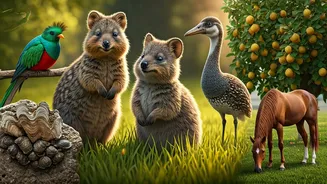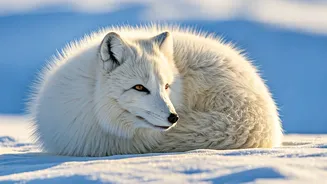Quetzal's Regal Beauty
The Resplendent Quetzal, found in the cloud forests of Central America, is a bird of extraordinary beauty. Known for its vibrant green plumage and elongated
tail feathers in males, it holds significant cultural importance. The Quetzal's diet consists mainly of fruits, insects, and small vertebrates. Its name comes from the Nahuatl word “quetzalli,” meaning “long tail feather,” which was a symbol of divinity and royalty for the Maya and Aztec civilizations. The male's long tail feathers, which can grow up to a meter in length, are especially stunning. These birds play a crucial role in seed dispersal within their forest ecosystems, making them essential to their habitat's health. They often nest in tree cavities, contributing to the biodiversity of the forests.
Quokka's Perpetual Smile
The Quokka, a small marsupial native to Western Australia, is famous for its friendly demeanor and seemingly permanent smile. These adorable animals, often found on Rottnest Island, are highly photogenic and have become a popular attraction for tourists. Quokkas are primarily nocturnal and herbivorous, feeding on leaves, stems, and bark. They are well-adapted to their environment, surviving in harsh conditions. Despite their popularity, quokkas are classified as vulnerable due to habitat loss and predation. Conservation efforts are crucial to ensuring these charming creatures continue to thrive. Their ability to coexist peacefully with humans also makes them unique.
Quail's Camouflage Mastery
Quails, belonging to the Phasianidae family, are small, ground-dwelling birds known for their excellent camouflage and rapid flight. Various species of quail inhabit different parts of the world, from North America to Asia and Europe. Their plumage often blends perfectly with their surroundings, making them difficult for predators to spot. These birds are primarily seed-eaters, but they also consume insects and other small invertebrates. Quails are known for their strong family bonds, with both parents often involved in raising their chicks. The eggs of quails are a popular food source, and some species are farmed for meat and eggs.
Quelea's Social Swarms
The Red-billed Quelea, native to Africa, is known for its incredible flocking behaviour. These small weaverbirds can form some of the largest bird flocks in the world, sometimes numbering in the millions. Their massive flocks can cause significant damage to crops, making them a pest for farmers. Queleas are primarily granivorous, feeding on seeds from grasses and cereals. Their breeding cycles often coincide with the rainy season, when food is most abundant. Despite their destructive habits, queleas are an important part of the ecosystem, providing food for predators and contributing to seed dispersal.
Quetzalcoatl's Legacy
Quetzalcoatlus is a genus of pterosaur that lived during the late Cretaceous period. This giant flying reptile, discovered in North America, is one of the largest known flying animals of all time. With an estimated wingspan of over 10 meters, it would have been a truly awe-inspiring sight. Scientists believe it may have fed on fish and other small animals, possibly wading in shallow waters. The name Quetzalcoatlus honors the Aztec feathered serpent god, reflecting the grandeur and significance of the fossil discovery. These magnificent creatures provide invaluable insights into the prehistoric world.
Quartzite's Secret Life
While not an animal, this section acknowledges the common usage of “quartzite” in animal names. Quartzite is a metamorphic rock composed mainly of quartz and found in various environments. The mention serves as a reminder that “quartzite” is sometimes found in animal names, though not directly related to the species itself. The unique nature of “quartzite” helps demonstrate the vast differences in the usage of names, and the wide range of terms used in the context of the natural world.
Quillback's Defense
The Quillback, also known as the White Sucker, is a freshwater fish found throughout North America. It is characterized by its long, quill-like scales, which provide protection from predators. Quillbacks are bottom feeders, consuming insects, crustaceans, and organic matter. They play a role in maintaining the balance of their aquatic ecosystems. Their name stems from their scales' unique structure, resembling quills. These fish are adaptable, residing in various habitats such as lakes, rivers, and streams. The quillback serves as an example of nature's evolutionary adaptations.
Qilin's Mystical Presence
The Qilin, also known as the Chinese unicorn, is a mythical creature in East Asian cultures. Often depicted as a composite animal, the qilin combines features of various animals, such as a dragon's head, a deer's body, and a horse's hooves. The qilin symbolizes good omens, prosperity, and longevity. It is believed to be a benevolent creature that only appears during the reign of a wise and just ruler. The qilin is often featured in art, literature, and folklore across China, Korea, and Japan, representing moral values. This mythical being embodies the spiritual and cultural richness of the region's traditions and beliefs.













